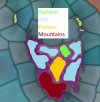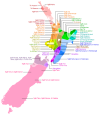Hello, and welcome to another Friday devoted to map worship! You may remember me, Pavía, from previous Tinto Maps, as @Roger Corominas has been dutifully taking care of the last 6 dev diaries. Now he’s focusing on some other tasks, and I’ll be in charge of the last 4, as it’s planned that the war Tinto Maps will be over by Christmas. This doesn’t mean that we will be done with the maps of Project Caesar, though - we will continue posting Tinto Maps Feedback posts in the next few months. And the next one will be a very much anticipated one - the Balkans, next week! But let’s focus now on today’s region: Oceania!
Countries

A bit different map today, as there are no regular countries in the entire region… All of them are Societies of Pops! Also, down to the right, that is not ‘Linear Atlantis’, but our ‘3D Material Testing Island’, where our (great) 3D artists test how the different combinations of terrains look in-game.
It may be relevant to repeat our guidelines for how to categorize countries and societies, by the way:
Societies of Pops



There are a few Societies of Pops in Oceania, in three main hubs: Hawaii, Fiji-Samoa-Tonga, and New Zealand. We’d be interested in listening to your feedback on this matter, nonetheless.
Locations








 Plenty of different maps today, to be able to show as many different regions as possible. This is very highly WIP, and some of the islands may end up dying because of their size and being unimportant. By the way, you may notice that some of the islands are weirdly rounded up - that’s because they have a different type of terrain, ‘Atoll’, which is the last one that we were able to add to the game in due time during the development process.
Plenty of different maps today, to be able to show as many different regions as possible. This is very highly WIP, and some of the islands may end up dying because of their size and being unimportant. By the way, you may notice that some of the islands are weirdly rounded up - that’s because they have a different type of terrain, ‘Atoll’, which is the last one that we were able to add to the game in due time during the development process.
Provinces



Areas

Terrain



Now you may fully notice the purpose of Terrain Testing Island!
Development

Not a very developed region in 1337…
Natural Harbors


There are some very good natural harbors in the region, including a very infamous one in O’ahu…
Cultures




Tons of different cultures today!
Languages


Papua is not the most homogeneous place in the world, language-related…
Religions

As mentioned last week, we’ve split Animism into several ‘cultural confessions’, which we want now to recombine into broader families; so, again, any suggestions are welcome!
Raw Materials





 Resources are, in general terms, quite basic, food-oriented ones; although Australia is more varied, obviously, and there are some areas very rich in Pearls.
Resources are, in general terms, quite basic, food-oriented ones; although Australia is more varied, obviously, and there are some areas very rich in Pearls.
Markets

Ternate is the main market of the western part of the region, although you may notice that there’s very little access in most of the locations.
Population
There are some issues with the Population distribution map of the region this week, but I’m letting you know that the total population is 1.885M.
And that is all for today! If you want a more detailed map of a given area, just let me know, as I’m aware that the scale of the region shown doesn’t fit well with the usual format of Tinto Maps.
Next week we will take a look at the last continent remaining, starting with the region of North America. See you!
Countries

A bit different map today, as there are no regular countries in the entire region… All of them are Societies of Pops! Also, down to the right, that is not ‘Linear Atlantis’, but our ‘3D Material Testing Island’, where our (great) 3D artists test how the different combinations of terrains look in-game.
It may be relevant to repeat our guidelines for how to categorize countries and societies, by the way:
Societies of Pops



There are a few Societies of Pops in Oceania, in three main hubs: Hawaii, Fiji-Samoa-Tonga, and New Zealand. We’d be interested in listening to your feedback on this matter, nonetheless.
Locations









Provinces



Areas

Terrain



Now you may fully notice the purpose of Terrain Testing Island!
Development

Not a very developed region in 1337…
Natural Harbors


There are some very good natural harbors in the region, including a very infamous one in O’ahu…
Cultures




Tons of different cultures today!
Languages


Papua is not the most homogeneous place in the world, language-related…
Religions

As mentioned last week, we’ve split Animism into several ‘cultural confessions’, which we want now to recombine into broader families; so, again, any suggestions are welcome!
Raw Materials






Markets

Ternate is the main market of the western part of the region, although you may notice that there’s very little access in most of the locations.
Population
There are some issues with the Population distribution map of the region this week, but I’m letting you know that the total population is 1.885M.
And that is all for today! If you want a more detailed map of a given area, just let me know, as I’m aware that the scale of the region shown doesn’t fit well with the usual format of Tinto Maps.
Next week we will take a look at the last continent remaining, starting with the region of North America. See you!






